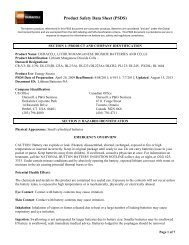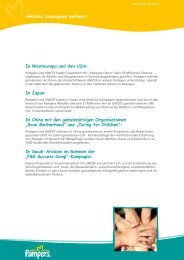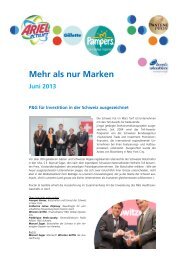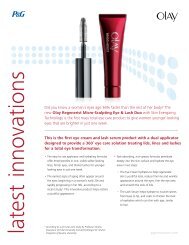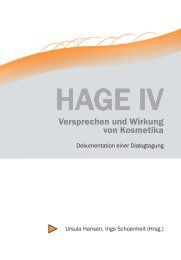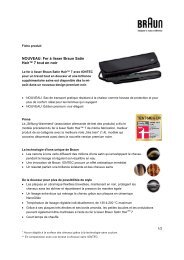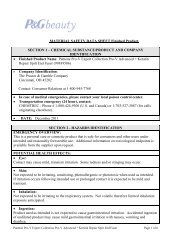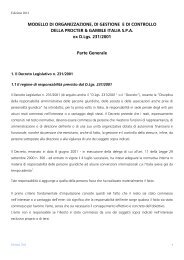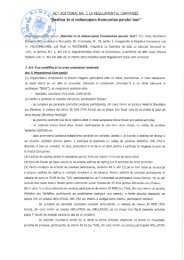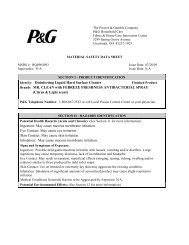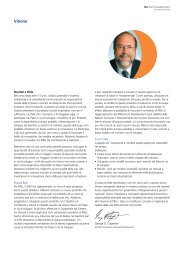P&G 2009 Annual Report – AnnualReports.com - Procter & Gamble
P&G 2009 Annual Report – AnnualReports.com - Procter & Gamble
P&G 2009 Annual Report – AnnualReports.com - Procter & Gamble
You also want an ePaper? Increase the reach of your titles
YUMPU automatically turns print PDFs into web optimized ePapers that Google loves.
54 The <strong>Procter</strong> & <strong>Gamble</strong> Company<br />
Notes to Consolidated Financial Statements<br />
NOTE 1<br />
SUMMARY OF SIGNIFICANT ACCOUNTING POLICIES<br />
Nature of Operations<br />
The <strong>Procter</strong> & <strong>Gamble</strong> Company’s (the “Company,” “we” or “us”)<br />
business is focused on providing branded consumer goods products<br />
of superior quality and value. Our products are sold in more than<br />
180 countries primarily through retail operations including mass<br />
merchandisers, grocery stores, membership club stores, drug stores,<br />
department stores, salons and high-frequency stores. We have onthe-ground<br />
operations in approximately 80 countries.<br />
Basis of Presentation<br />
The Consolidated Financial Statements include the Company and its<br />
controlled subsidiaries. Inter<strong>com</strong>pany transactions are eliminated.<br />
Use of Estimates<br />
Preparation of financial statements in conformity with accounting<br />
principles generally accepted in the United States of America (U.S. GAAP)<br />
requires management to make estimates and assumptions that affect<br />
the amounts reported in the Consolidated Financial Statements and<br />
ac<strong>com</strong>panying disclosures. These estimates are based on management’s<br />
best knowledge of current events and actions the Company may<br />
undertake in the future. Estimates are used in accounting for, among<br />
other items, consumer and trade promotion accruals, pensions, postemployment<br />
benefits, stock options, valuation of acquired intangible<br />
assets, useful lives for depreciation and amortization, future cash<br />
flows associated with impairment testing for goodwill, indefinite-lived<br />
intangible assets and long-lived assets, deferred tax assets, uncertain<br />
in<strong>com</strong>e tax positions and contingencies. Actual results may ultimately<br />
differ from estimates, although management does not generally<br />
believe such differences would materially affect the financial statements<br />
in any individual year. However, in regard to ongoing impairment<br />
testing of goodwill and indefinite-lived intangible assets, significant<br />
deterioration in future cash flow projections or other assumptions used<br />
in valuation models, versus those anticipated at the time of the initial<br />
valuations, could result in impairment charges that may materially<br />
affect the financial statements in a given year.<br />
Revenue Recognition<br />
Sales are recognized when revenue is realized or realizable and has<br />
been earned. Most revenue transactions represent sales of inventory.<br />
The revenue recorded is presented net of sales and other taxes we<br />
collect on behalf of governmental authorities and includes shipping<br />
and handling costs, which generally are included in the list price to the<br />
customer. Our policy is to recognize revenue when title to the product,<br />
ownership and risk of loss transfer to the customer, which can be on the<br />
date of shipment or the date of receipt by the customer. A provision<br />
for payment discounts and product return allowances is recorded as a<br />
reduction of sales in the same period that the revenue is recognized.<br />
Amounts in millions of dollars except per share amounts or as otherwise specified.<br />
Trade promotions, consisting primarily of customer pricing allowances,<br />
merchandising funds and consumer coupons, are offered through<br />
various programs to customers and consumers. Sales are recorded net of<br />
trade promotion spending, which is recognized as incurred, generally<br />
at the time of the sale. Most of these arrangements have terms of<br />
approximately one year. Accruals for expected payouts under these<br />
programs are included as accrued marketing and promotion in the<br />
accrued and other liabilities line item in the Consolidated Balance Sheets.<br />
Cost of Products Sold<br />
Cost of products sold is primarily <strong>com</strong>prised of direct materials and<br />
supplies consumed in the manufacture of product, as well as manufacturing<br />
labor, depreciation expense and direct overhead expense<br />
necessary to acquire and convert the purchased materials and supplies<br />
into finished product. Cost of products sold also includes the cost to<br />
distribute products to customers, inbound freight costs, internal transfer<br />
costs, warehousing costs and other shipping and handling activity.<br />
Selling, General and Administrative Expense<br />
Selling, general and administrative expense (SG&A) is primarily <strong>com</strong>prised<br />
of marketing expenses, selling expenses, research and development<br />
costs, administrative and other indirect overhead costs, depreciation<br />
and amortization expense on non-manufacturing assets and other<br />
miscellaneous operating items. Research and development costs are<br />
charged to expense as incurred and were $2,044 in <strong>2009</strong>, $2,212 in<br />
2008, and $2,100 in 2007. Advertising costs, charged to expense<br />
as incurred, include worldwide television, print, radio, internet and<br />
in-store advertising expenses and were $7,579 in <strong>2009</strong>, $8,583 in<br />
2008 and $7,850 in 2007. Non-advertising related <strong>com</strong>ponents of<br />
the Company’s total marketing spending include costs associated with<br />
consumer promotions, product sampling and sales aids, all of which<br />
are included in SG&A, as well as coupons and customer trade funds,<br />
which are recorded as reductions to net sales.<br />
Other Non-Operating In<strong>com</strong>e, Net<br />
Other non-operating in<strong>com</strong>e, net, primarily includes net divestiture<br />
gains and interest and investment in<strong>com</strong>e.<br />
Currency Translation<br />
Financial statements of operating subsidiaries outside the United<br />
States of America (U.S.) generally are measured using the local<br />
currency as the functional currency. Adjustments to translate those<br />
statements into U.S. dollars are recorded in other <strong>com</strong>prehensive<br />
in<strong>com</strong>e. Currency translation adjustments in accumulated other<br />
<strong>com</strong>prehensive in<strong>com</strong>e were gains of $3,333 and $9,484 at June 30,<br />
<strong>2009</strong> and 2008, respectively. For subsidiaries operating in highly<br />
inflationary economies, the U.S. dollar is the functional currency.<br />
Remeasurement adjustments for financial statements in highly<br />
inflationary economies and other transactional exchange gains and<br />
losses are reflected in earnings.



